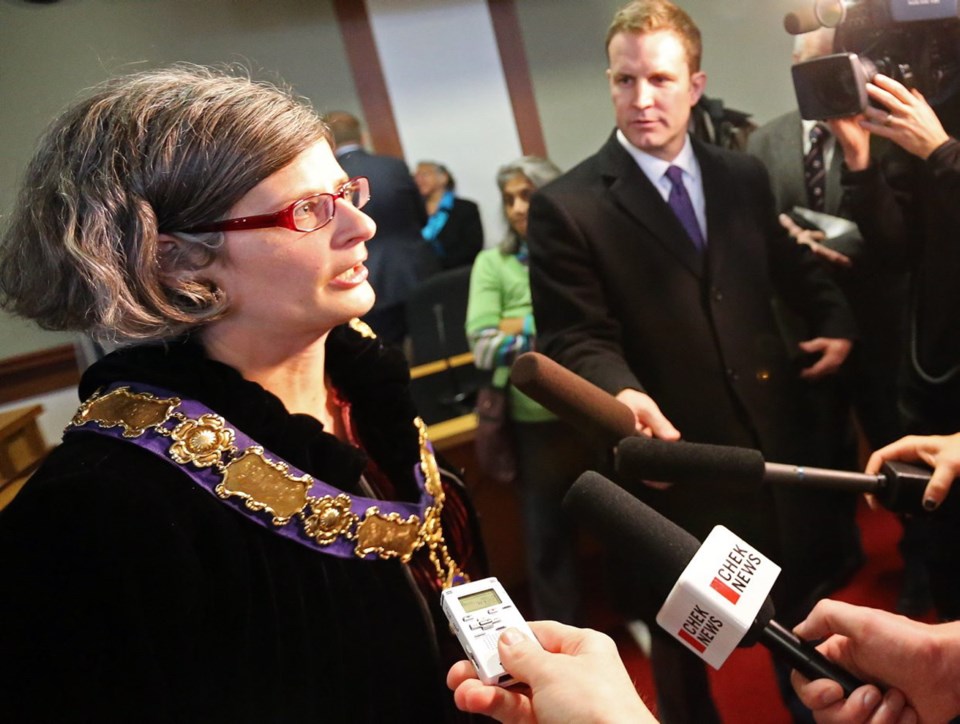Victoria staff are recommending getting back to basics as the city develops citizen-engagement plans for sewage treatment.
“The public didn’t buy into the original [Capital Regional District] plan for all sort of reasons, maybe some misinformation but a feeling of not being heard or not being listened to,” said Mayor Lisa Helps.
“I would like it to be a plan the public can get behind.”
But Coun. Ben Isitt says that with half a billion dollars in senior government funding for sewage treatment hanging in the balance, time is of the essence and the city should be getting on with the more difficult issue of site selection.
“I think until we actually get down to specifics of where our potential sites in the city and other potential sites are in other municipalities, we’re kind of just beating around the bush,” Isitt said Monday.
“They’re going to be hard discussions but I think it’s time for us to begin having those discussions about where these facilities can be located.”
Helps said site selection is important, but the governance of sewage needs to be sorted out first. The current plan for sewage treatment is region-wide, so any switch to a sub-regional solution — such as a west-side or east-side plan — would need to be approved.
Victoria has hired consultants and begun working with Saanich and Oak Bay staff to explore local or sub-regional treatment options since the collapse last summer of the Capital Regional District’s plan to locate a plant at Esquimalt’s McLoughlin Point.
In a report going to councillors Thursday, municipal staff present a strategy to begin in January to outline to the public:
• how the existing system works and the benefits of sewage treatment
• wastewater treatment processes and technologies
• differences and considerations in deciding between centralized and distributed systems
• resource recovery
• plants in other communities.
Isitt says he’s maintained since the province refused to overturn Esquimalt’s decision not to rezone McLoughlin that the most important next step is to find a replacement site.
The problem, Isitt said, is that council hasn’t given city staff firm direction to begin the process of site selection, something he plans to propose Thursday.
“I’m worried on two grounds — the biggest one is the ongoing negative impact to the environment by disposing of sewage into the ocean.”
The other problem is the risk of losing half a billion dollars in senior-government funding, which would mean each household’s cost for the project would rise from approximately $300 to potentially $1,000 or more per year, he said. The CRD is supposed to have a plant running by 2018 to meet federal and provincial government funding deadlines.
Isitt said he doesn’t oppose public consultation, but most people already accept that the region has an ethical and legal responsibility to treat its wastewater.
“So it’s not a question of whether or not to treat,” he said. “It’s a question of how to treat and where and I think through the process of site selection, we can look at the questions around technology and even around governance.”
Meanwhile, on the west side of the region, a survey is asking residents for input on a potential sewage-treatment strategy for Colwood, Esquimalt, Langford, View Royal and the Songhees nation.
The survey is online at www.crd.bc.ca/westside-solutions.
Residents can also learn more at an open house today from 5 to 7 p.m. at the Songhees Wellness Centre. It’s the first in a series of public discussions that will be hosted in each of the westside communities.
“Are people prepared to have a [sewage treatment facility] in their community? Do they want the cheapest option or the most technical? It will identify the next roads to take,” said Colwood Mayor Carol Hamilton, who is co-chairwoman of the Westside Wastewater and Resource Recovery Select Committee with Esquimalt Mayor Barb Desjardins.
Hamilton said that, given the timelines imposed by the federal and provincial governments, it was time to start moving.
“We can’t lose momentum,” she said.
“We’re fairly confident that if people are fairly engaged in working toward a solution, we can get there.”



